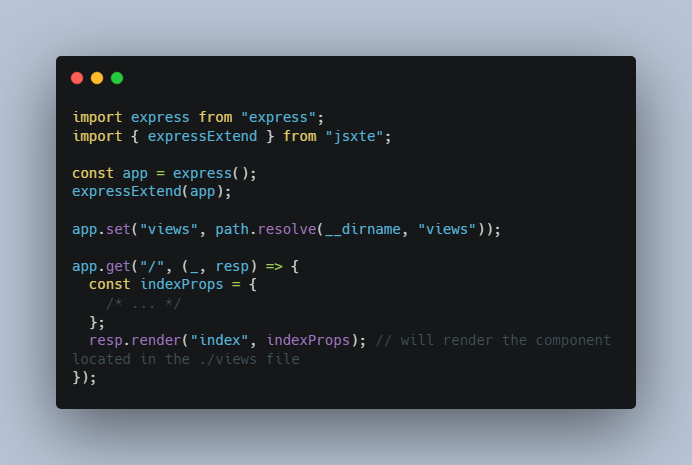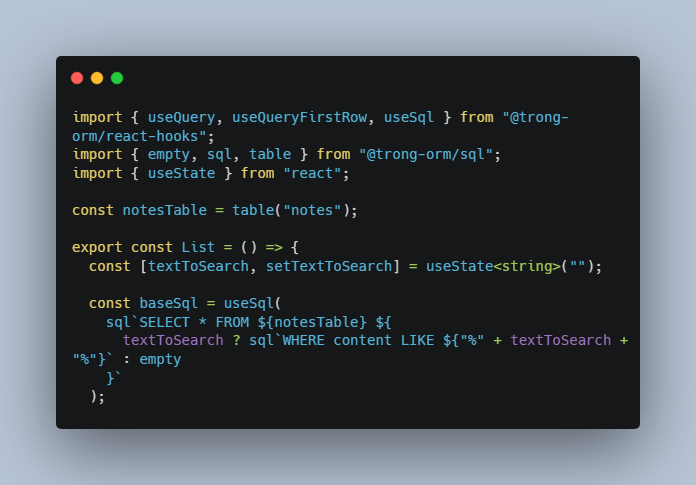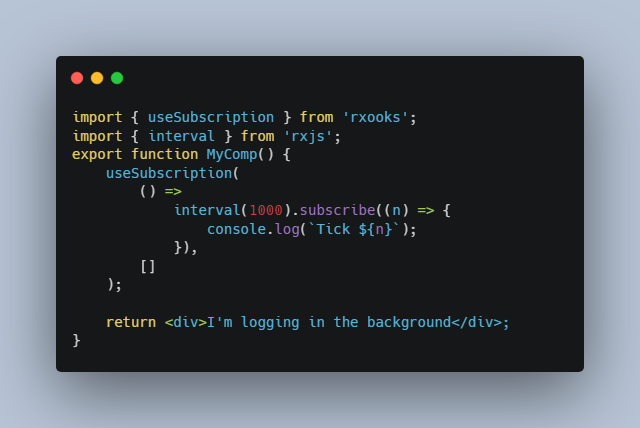JSX Template Engine
A JSX based html templating engine for browsers or Node environments.
Getting started
To use the jsxte you will have to set up your transpiler to use this package for transforming the JSX syntax, if you use typescript for transpiling all you have to do is set these options in the tsconfig:
{
"compilerOptions": {
"jsx": "react-jsx",
"jsxImportSource": "jsxte"
}
}
If you use something else, like babel you will also need to adapt the configuration of that, for example: https://babeljs.io/docs/en/babel-plugin-transform-react-jsx
Once you are done with that you can start writing your templates and rendering them.
import { renderToHtml } from "jsxte";
const Header = (props: { label: string }) => {
return <h1>{props.label}</h1>;
};
const App = (props: { label: string }) => {
return (
<html>
<head>
<meta charset="utf-8" />
<meta http-equiv="X-UA-Compatible" content="IE=edge" />
<meta name="viewport" content="width=device-width, initial-scale=1" />
</head>
<body>
<Header label={props.label} />
</body>
</html>
);
};
const html = renderToHtml(App, { label: "Hello World!" });
Asynchronous Components
In case you use the templates in a server app in a Node environment you might want to include some data from the database in the html you serve to the client. To make it easier to fetch what’s needed and marry it with the templates you can make your components asynchronous and send async requests from within them.
import { renderToHtmlAsync } from "jsxte";
const Header = () => {
return <h1>Hello World</h1>;
};
const ToDoList = async () => {
const todos = await fetchMyTodosFromDB();
return (
<table>
<thead>
<tr>
<th>Label</th>
<th>Is Done?</th>
</tr>
</thead>
<tbody>
{todos.map((todo) => (
<tr>
<td>{todo.label}</td>
<td>{todo.isDone ? "yes" : "no"}</td>
</tr>
))}
</tbody>
</table>
);
};
const App = () => {
return (
<html>
<head>
<meta charset="utf-8" />
<meta http-equiv="X-UA-Compatible" content="IE=edge" />
<meta name="viewport" content="width=device-width, initial-scale=1" />
</head>
<body>
<Header />
<h3>ToDo's:</h3>
<ToDoList />
</body>
</html>
);
};
// If your component contains an asynchronous component at any point, `renderToHtmlAsync` needs to be used instead of `renderToHtml`
const html = await renderToHtmlAsync(App, { label: "Hello World!" });
Express JS View Engine
You can also use jsxte with the Express View Engine. To do that, use the expressExtend to add the engine support, specify the views directory and then use the express response method .render(). The .render() method takes the component props as it’s second argument.
import express from "express";
import { expressExtend } from "jsxte";
const app = express();
expressExtend(app);
app.set("views", path.resolve(__dirname, "views"));
app.get("/", (_, resp) => {
const indexProps = {
/* ... */
};
resp.render("index", indexProps); // will render the component located in the ./views file
});
For this approach to work, the JSX Components must be exported as defaults (ex. export default () => <div></div> or exports.default = () => <div></div>) and the views must be transpiled to .js files.





